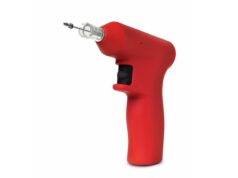 Panos Kitrou is a consultant interventional radiologist at Patras University Hospital (Patras, Greece). He writes to set out “the need for a benchmark volume flow (VF) measurement for every vascular access”.
Panos Kitrou is a consultant interventional radiologist at Patras University Hospital (Patras, Greece). He writes to set out “the need for a benchmark volume flow (VF) measurement for every vascular access”.
Normal function of a vascular access, either an arteriovenous fistula (AVF) or an arteriovenous graft (AVG), is a prerequisite for end-stage kidney disease (ESKD) patients undergoing haemodialysis. Complications such as stenosis within the circuit leading to dysfunction or finally thrombosis, and are urgent situations that not only require immediate treatment but also compromise the longevity of the vascular access itself.
The decision for intervention to a vascular access is based on clinical criteria of a stenosis within the vascular access circuit which are verified angiographically based on anatomical criteria (>50% stenosis). Percutaneous vascular access treatment is recommended by both Kidney Disease Outcomes Quality Initiative (KDOQI) Guidelines (2019) and the European Society for Vascular Surgery (ESVS) Guidelines (2018) as a valid option for treatment improving its survival.1, 2 The different percutaneous options include percutaneous transluminal angioplasty (PTA), paclitaxel-coated balloon (PCB), scoring balloons (SB), cutting balloons (CB), bare metal stents (BMS) and covered stents (CS) placement. Nonetheless, any improvement provided is susceptible to restenosis.
What is more, the procedural outcomes of endovascular procedures are quantified by anatomical criteria based on angiographic or duplex ultrasound (US) images on the principle of <30% residual stenosis at the end of the procedure. The latter does not take into consideration the important haemodynamic component of vascular access functionality which is the VF measurement (measurement of blood flow velocity employing Doppler techniques in combination with calculation of the approximate cross-sectional vessel area) at the level of the brachial artery, which is the feeding vessel, in the case of upper limb circuits. Additionally, the KDOQI guidelines have de-emphasised the need for ultrasound surveillance and the introduction of haemodynamic criteria in vascular access surveillance. This decision was based on previous studies that used indirect flow measurement with optodilutional and ultrasound dilution methods, performed intradialytically, requiring line reversal. These methods are time-consuming, demanding expensive equipment and flow measurement results cannot be compared directly between different devices.
Over the last few years, the evolution and increased presence of ultrasound devices in dialysis clinics, nephrology, and surgery departments, and cath labs, made ultrasound examination easily available and accessible. What is more, ultrasound examination, is a fast and reproducible procedure. Notably, VF measurements are nowadays part of the ultrasound software. Haemodynamic variables already play a crucial role in other vascular beds. Fractional flow reserve (FFR) is an established assessment method in coronary artery disease and peak systolic velocity ratio (PSVR) in peripheral arterial disease. Hence, the use of ultrasound should not be restricted to surveillance. Although anatomical considerations are important (degree of stenosis), the introduction of haemodynamic endpoints could further add to our decision-making process. A benchmark VF value of a normal functioning vascular access is important to function as a benchmark value for every vascular access. Based on this value physicians can evaluate VF decrease and theoretically pre-emptively intervene. More importantly, by measuring VF intra-procedurally, a decision can be made on whether further dilatation or scaffold implantation is needed in a procedure.
Although a VF of 600ml/min is suggested as a haemodynamic criterion for maturation, it is known that, when functional, AVFs and AVGs behave differently and need different VF thresholds to perform prescribed haemodialysis. Many investigators have used different VF cut-off levels between the two circuit types to discern stenosis. Driven by observational data, a VF cut-off of <700-800ml/min has been recommended to instigate more imaging studies and potential intervention in AVGs compared to a VF cut-off of <400ml/min in case of AVFs.3 Other studies have also proposed different VF thresholds for diagnosis of flow-limiting stenoses depending on level of anatomy. Namely, investigators have proposed a VF threshold of <600ml/min for forearm and <900ml/min for upper-arm AVFs. Still, there is no definitive recommended VF threshold for intervention in the current literature with reported VF rates ranging from 350 to 800 ml/min.4, 5
A recent meta-analysis by Ali et al, published after the guidelines were available, and including 10 studies and 1,430 patients, concluded that “haemodialysis access surveillance using access blood flow monitoring can reduce the risk of access thrombosis for patients with AV-fistulas, but this is not the case with AV-grafts”.6 On the other hand, no suggestion or recommendation has been provided on the need for a benchmark VF for every vascular access. In other words, the need for a baseline VF measurement that will be used to evaluate not only if a vascular access is functional/dysfunctional in the future, but also the outcomes of endovascular procedures.
To add to that, none of the guidelines explore or recommend the intra-procedural utilisation of VF measurements as a haemodynamic endpoint or in the process of decision making. A recent study by Spiliopoulos et al investigated the sequential intraprocedural VF measurements using percutaneous DUS, to provide a physiological assessment of AVF PTA outcomes. In this pilot prospective study of 20 patients, intraprocedural VF measurements were well correlated with balloon angioplasty diameters and six month late lumen loss, while VF-guided angioplasty optimised immediate PTA outcomes. The authors reported that VF increase of approximal 150% compared to baseline could be used as a physiological endpoint of PTA with satisfactory sensitivity (66.7%) and specificity (85.7%).7
Given the increasing interest in VF’s role in vascular access a decision was made by the meeting directors, Dimitrios Karnabatidis, Konstantinos Katsanos and myself (all University of Patras, Patras, Greece), as well as Stavros Spiliopoulos (University of Athens, Athens, Greece), to create a Delphi consensus (EVAluating VOlume FLOw measurements in Vascular Access—the EVA VOFLOVA consensus) at the last EVA Meeting (23–24 June, Patras, Greece). The concept was to explore the opinion of global vascular access experts and hopefully come to a consensus on this interesting and important topic.
The consensus questions are focused and divided into three different categories (chapters), namely the VF surveillance of vascular access that no previous intervention has taken place (chapter 1), post-procedural VF surveillance (chapter 3) and the utility of VF measurements intra-procedurally as a tool for decision making (chapter 2). The questionnaire applies for both AVFs and AVGs. Given the fact that evidence from properly powered randomised trials is missing, this consensus could work as a trigger for further research. In the era of tailored medicine, VF measurements may provide an additional tool to better understand and treat vascular access with an aim to improve healthcare provided to haemodialysis patients.
Kitrou cited no relevant disclosures.
References
- Lok CE, Huber TS, Lee T, et al. KDOQI Clinical Practice Guideline for Vascular Access: 2019 Update. Am J Kidney Dis. 2020;75(4 Suppl 2):S1-S164.
- Schmidli J, Widmer MK, Basile C, et al. Editor’s Choice—Vascular Access: 2018 Clinical Practice Guidelines of the European Society for Vascular Surgery (ESVS). Eur J Vasc Endovasc Surg. 2018;55(6):757-818.
- Bandyk DF. Interpretation of duplex ultrasound dialysis access testing. Semin Vasc Surg. 2013;26(2-3):120-6.
- Yii E, Lee L, Polkinghorne K, et al. Optimal flow volume measurements in forearm versus arm arteriovenous fistulas. Nephrology (Carlton). 2023;28(3):175-80.
- Polkinghorne KR, Lau KK, Saunder A, et al. Does monthly native arteriovenous fistula blood-flow surveillance detect significant stenosis–a randomized controlled trial. Nephrol Dial Transplant. 2006;21(9):2498-506.
- Ali H, Mohamed MM, Baharani J. Effects of haemodialysis access surveillance on reducing risk of haemodialysis access thrombosis: A meta-analysis of randomized studies. Hemodial Int. 2021.
- Spiliopoulos S, Giannikouris IE, Katsanos K, et al. VOLume flow assistance for optimizing outcomes of dysfunctional autologous arteriovenous fistula Angioplasty: the VOLA Pilot Study. Eur Radiol. 2022;32(1):368-76.












